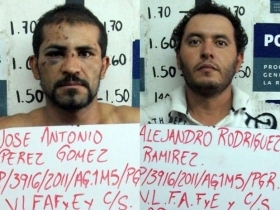The Mexican Army says that six different gangs are currently fighting for control of Jalisco, making the populous Pacific state a microcosm of the shifting alliances and ever-changing fronts of battles raging across the nation.
As Excelsior reported, General Genaro Fausto Lozano pointed to six gangs fighting for control of Jalisco: the Sinaloa Cartel, the Jalisco Cartel – New Generation (CJNG, for its initials in Spanish), the Resistance, the Caballeros Templarios, the Familia Michoacana, and the Beltran Leyva Organization.
The absence of the Zetas from this list is striking. If Lozano is correct in excluding them, this would mark a sudden shift in the local landscape, but logic suggests it was simply an oversight by the military commander. Last fall, the Zetas were blamed for the massacre of dozens of youths, whose bodies were left inside a truck parked in the middle of Guadalajara. In October, an Excelsior reporter rode along with a military detachment as they searched for Zetas (and other gangs) along the Zacatecas-Jalisco border region. And last year, an article by two government officials, one of whom was Interior Secretary Alejandro Poire, detailed the incursion of the Zetas into the region as far back as 2010.
In any event, the collection of gangs mentioned by Lozano includes both recently emerging, primarily local groups (the Resistance and the CJNG) and the transnational gangs for which Mexico is notorious (principally the Sinaloa Cartel). The larger gangs often pair up with locals to fight a common enemy, but the patchwork of alliances does little to smooth over what is an increasingly chaotic situation.
Indeed, it is often exceedingly difficult to determine the composition of the alliances on a given day, or tell where the dividing lines are. The CJNG are said to be the local agents of the Sinaloa Cartel, because they have a common enemy (the Zetas) and because they are thought to be staffed by the former lieutenants of deceased Sinaloa capo Nacho Coronel.
But it’s not clear that the links between the two groups are particularly extensive or that they will prove enduring. It’s perhaps noteworthy that Coronel’s old subordinates regrouped under a new name, rather than incorporating themselves into the Sinaloa Cartel. It is also worth mentioning that the CJNG play for the Zetas stronghold of Veracruz comes without any conspicuous role from their supposed masters in the Sinaloa foothills. And on at least one occasion, a message left with a dead body and signed by the CJNG has taunted Sinaloa.
The nuances of the relationships among the other gangs operating in Jalisco are similarly unclear. The Resistance has been described as allied to the Zetas and to the Familia Michoacana, though other reports have depicted them as enemies of both these groups. This interplay among the Jalisco gangs demonstrates that, contrary to the widespread belief that all smaller groups are subsidiaries to one of the larger networks, the low-level gangs have been able to carve out an autonomous toehold.
The local gangs operating in Jalisco and elsewhere also demonstrate that the model of the transnational group, controlling every step of production and transportation, is less and less relevant to today’s Mexico. Many of the gangs in Jalisco have no known connections to Colombia, nor do they control valuable plazas in the border region, nor do they have retail partners in the US. These groups, and others like them in Acapulco and elsewhere, either buy into another gang’s smuggling network in order to ship drugs northward, or they extract their profits from the local population, whether through extortion, kidnapping, car-jacking, or retail drug sales.
In this sense, Jalisco reflects one of the most important criminal dynamics across Mexico. Around the country, such smaller groups have emerged from the splinters of larger gangs brought down by competition and government pursuit. The growth of these regional gangs and the relative weakening of the hegemonic gangs has typically been a force for bloodshed. The upsurge in killings in Mexico amid this process is well documented, and has affected Jalisco over the past two years in particular: according to the National System of Public Security, the number of murders in the state leaped from 570 to 882 from 2009 to 2010, and jumped to more than 1,100 in the first 11 months of last year.

